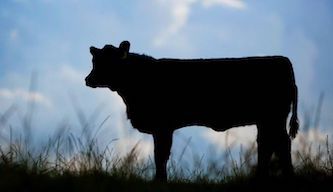Turnover from red meat processing in Scotland in 2023 is estimated to have risen for a fourth consecutive year — rising 1% to £975 million.
And, despite cost-of-living challenges, people in Scotland spent around 8% more on red meat in 2023 – particularly on more affordable cuts.
The estimates were included in the Quality Meat Scotland’s (QMS) presentation to stakeholders across the supply chain at Turriff Show on Monday, following the release of its Read Meat Industry Profile report.
The report also highlights that there are “significant opportunities” for the £2.8 billion Scottish red meat sector to further increase its contribution to Scotland’s economy and to food security across the UK.
QMS chair Kate Rowell said: “It is great to be here in Turriff today – the North East is an area with high shares of agricultural output activity despite making up less than 12% of Scotland’s agriculture area.
“Aberdeenshire is the main destination for store cattle for finishing in Scotland, with around 32% of male cattle aged between one and two reported in June 2023.
“In addition, it accounted for around one-third of Scotland’s abattoir production in 2023, 63% of the breeding sows and 11% of the lamb crop.
“The latest profile data highlights that there continues to be a strong appetite for beef in Scotland, with 86% of households buying beef compared to 83% in Great Britain as a whole.
“This popularity is offset by supply from a further reduction in the suckler herd, with beef cow numbers down by 2.5% year-on-year in December which is a trend we must tackle head on.”
Iain Macdonald, QMS Market Intelligence Manager and author of the 2024 Red Meat Industry Profile, said: “Despite a more favourable market for store and finished cattle and a slight reduction in the number of store animals moving to England and Wales from the 2022 peak, it is a concern that Scotland’s beef herd continued to decrease in the second half of the year.
“There was also an annual fall in calf registrations of 2.7%, and this will result in a fall in prime beef output once these cattle reach peak slaughter age in 2025.
“We know from modelling work that there is significant economic potential in Scotland’s iconic beef sector, but action to stabilise the beef breeding herd, boost productivity and to reduce the outflow of store cattle is needed to reverse the decline and support recovery.
“This could support an extra £73.6 million of output and £16.9 million of GVA from the sector in 2030 compared to 2023.”
In the sheep sector, annual average market prices edged closer to the highs seen in 2021, with the Spring of 2023 hogg prices fixed at record levels over a number of weeks.
Macdonald said: “There was a notable spike in lamb prices around Easter and Ramadan despite strong availability of hoggs due to the delayed sale of the 2022 lamb crop, highlighting a strength of demand.
“Once the 2023 lamb crop began to reach the market, prices received support from a lower supply — driven by a reduced lambing rate due to the impact of a dry autumn in 2022 on ewe condition at mating.
“In addition, while there was some increase in lamb imports to the UK from Australia and New Zealand in the second half of the year, UK export demand remained strong due to a declining EU sheep flock, ensuring a tight domestic market.”
In 2023, Scotland’s pig sector continued to recover slowly from the financial crisis of 2021-22.
Macdonald added: “Farmgate pig prices remained at record levels following a rebalancing in 2022 as production ran at a significantly lower level, while input costs fell back from their peak, supporting increased margins.
“However, the scale of the previous crisis had a lasting effect, limiting confidence and the pig herd stabilised rather than rebounded.
“A similarly tight supply in the EU underpinned import prices, supporting the competitiveness of home-produced pork in the domestic market, but exports slumped due to the lack of supply in the home market.”
Macdonald concluded: “Overall, the red meat supply chain faced a challenging year in 2023 with elevated input costs and rising interest rates to deal with, as well as issues with recruiting skilled and affordable labour to replace leavers.
“The positives are that red meat processing sales continued to increase and that people in Scotland spent more on red meat despite a cost-of-living crisis, highlighting its continued importance in supporting healthy balanced diets.
“Looking forward, transformation in beef production away from the current trajectory is paramount to harnessing the full economic potential of this highly valued produce at home and beyond.
“This becomes particularly important when considering that the UK is a net importer of beef, and this gap is only going to grow much wider in the coming years if domestic production contracts in line with existing trends while a growing population puts upwards pressure on consumption.
“This could mean higher imports from countries with different levels of production standards and where weather extremes are likely to increase over time due to climate change.
“Meanwhile, it is vital that Scotland’s specialist sheep and pig sectors retain the confidence to keep investing in products which contribute so significantly to Scotland’s rural economy and to food security across the UK.”
